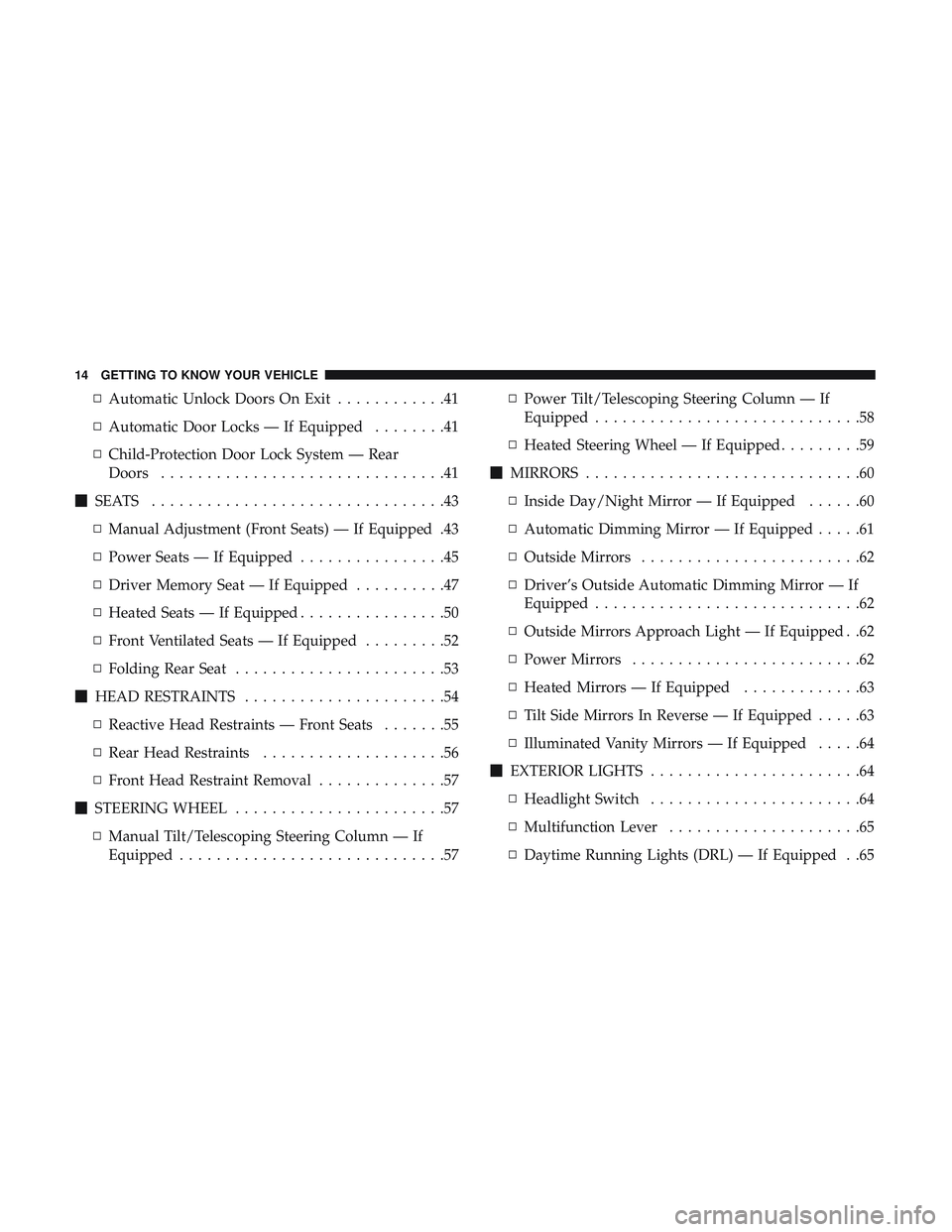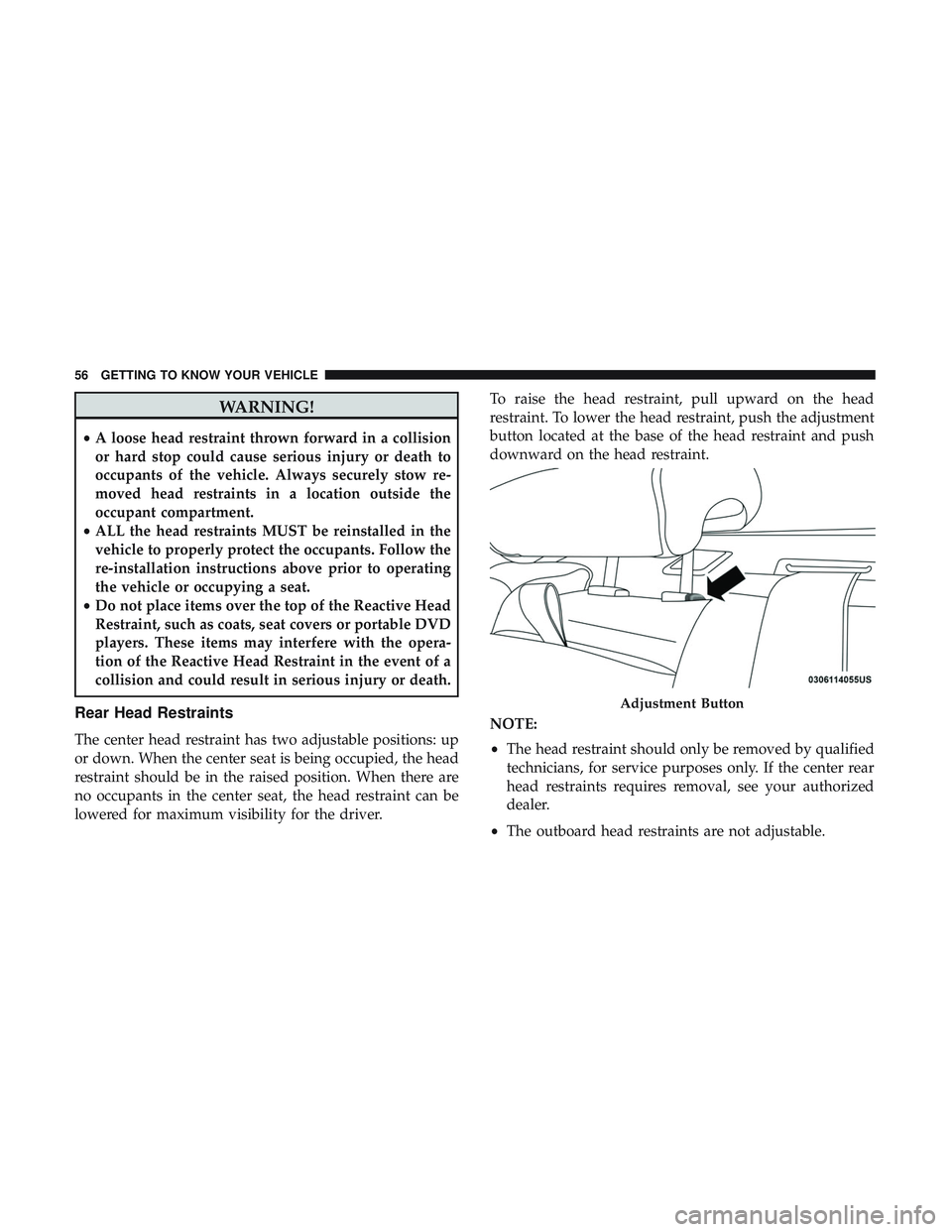Page 16 of 553

▫Automatic Unlock Doors On Exit ............41
▫ Automatic Door Locks — If Equipped ........41
▫ Child-Protection Door Lock System — Rear
Doors ...............................41
� SEATS ................................43
▫ Manual Adjustment (Front Seats) — If Equipped .43
▫ Power Seats — If Equipped ................45
▫ Driver Memory Seat — If Equipped ..........47
▫ Heated Seats — If Equipped ................50
▫ Front Ventilated Seats — If Equipped .........52
▫ Folding Rear Seat .......................53
� HEAD RESTRAINTS ......................54
▫ Reactive Head Restraints — Front Seats .......55
▫ Rear Head Restraints ....................56
▫ Front Head Restraint Removal ..............57
� STEERING WHEEL .......................57
▫ Manual Tilt/Telescoping Steering Column — If
Equipped .............................57 ▫
Power Tilt/Telescoping Steering Column — If
Equipped .............................58
▫ Heated Steering Wheel — If Equipped .........59
� MIRRORS ..............................60
▫ Inside Day/Night Mirror — If Equipped ......60
▫ Automatic Dimming Mirror — If Equipped .....61
▫ Outside Mirrors ........................62
▫ Driver’s Outside Automatic Dimming Mirror — If
Equipped .............................62
▫ Outside Mirrors Approach Light — If Equipped . .62
▫ Power Mirrors .........................62
▫ Heated Mirrors — If Equipped .............63
▫ Tilt Side Mirrors In Reverse — If Equipped .....63
▫ Illuminated Vanity Mirrors — If Equipped .....64
� EXTERIOR LIGHTS .......................64
▫ Headlight Switch .......................64
▫ Multifunction Lever .....................65
▫ Daytime Running Lights (DRL) — If Equipped . .65
14 GETTING TO KNOW YOUR VEHICLE
Page 57 of 553

WARNING!
•All occupants, including the driver, should not oper-
ate a vehicle or sit in a vehicle’s seat until the head
restraints are placed in their proper positions in
order to minimize the risk of neck injury in the event
of a crash.
• Head restraints should never be adjusted while the
vehicle is in motion. Driving a vehicle with the head
restraints improperly adjusted or removed could
cause serious injury or death in the event of a
collision.
NOTE: Do not reverse the head restraints (making the rear
of the head restraint face forward) in an attempt to gain
additional clearance to the back of your head.
Reactive Head Restraints — Front Seats
The front driver and passenger seats are equipped with
Reactive Head Restraints (RHR). In the event of a rear
impact, the RHRs will automatically extend forward mini-
mizing the gap between the back of the occupant’s head
and the RHR. The RHRs will automatically return to their normal posi-
tion following a rear impact. If the RHRs do not return to
their normal position, see your authorized dealer immedi-
ately.
To raise the head restraint, pull upward on the head
restraint. To lower the head restraint, push the adjustment
button located at the base of the head restraint and push
downward on the head restraint.
Adjustment Button
1 — Release Button
2 — Adjustment Button
3
GETTING TO KNOW YOUR VEHICLE 55
Page 58 of 553

WARNING!
•A loose head restraint thrown forward in a collision
or hard stop could cause serious injury or death to
occupants of the vehicle. Always securely stow re-
moved head restraints in a location outside the
occupant compartment.
• ALL the head restraints MUST be reinstalled in the
vehicle to properly protect the occupants. Follow the
re-installation instructions above prior to operating
the vehicle or occupying a seat.
• Do not place items over the top of the Reactive Head
Restraint, such as coats, seat covers or portable DVD
players. These items may interfere with the opera-
tion of the Reactive Head Restraint in the event of a
collision and could result in serious injury or death.
Rear Head Restraints
The center head restraint has two adjustable positions: up
or down. When the center seat is being occupied, the head
restraint should be in the raised position. When there are
no occupants in the center seat, the head restraint can be
lowered for maximum visibility for the driver. To raise the head restraint, pull upward on the head
restraint. To lower the head restraint, push the adjustment
button located at the base of the head restraint and push
downward on the head restraint.
NOTE:
•
The head restraint should only be removed by qualified
technicians, for service purposes only. If the center rear
head restraints requires removal, see your authorized
dealer.
• The outboard head restraints are not adjustable.
Adjustment Button
56 GETTING TO KNOW YOUR VEHICLE